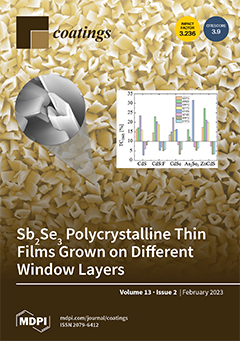In this study, a type of micro-nano Si
3N
4 matrix ceramic cutting tool material was successfully prepared by controlling the addition amount of TiC
0.7N
0.3 and the hot-pressing sintering temperature. The effects of different volume fractions of TiC
0.7
[...] Read more.
In this study, a type of micro-nano Si
3N
4 matrix ceramic cutting tool material was successfully prepared by controlling the addition amount of TiC
0.7N
0.3 and the hot-pressing sintering temperature. The effects of different volume fractions of TiC
0.7N
0.3 on the microstructure, mechanical properties, particle size distribution, and relative density of Si
3N
4 ceramic tools at the same temperature were investigated. The results show that the addition of TiC
0.7N
0.3 makes the β-Si
3N
4 grains with different diameters and aspect ratios interlaced and tightly bonded, thus achieving the strengthening and toughening effects. In addition, the effects of different hot-press sintering temperatures on the properties of Si
3N
4 ceramic tool materials were studied. It was concluded that the density of the material increased with the increase of the hot-pressing temperature. The relative density, flexural strength, and fracture toughness of the samples with 1 vol% TiC
0.7N
0.3 added at 1750 °C and 30 MPa pressure reached 99.22%, 993 MPa, and 9.81 MPa·m
1/2, respectively.
Full article





